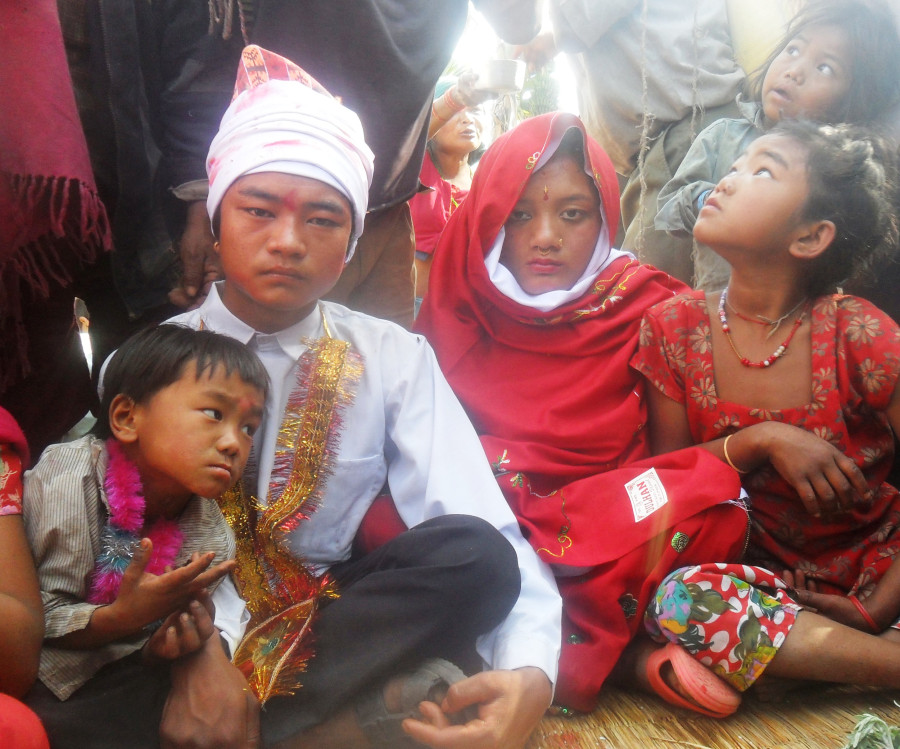National
Child marriage still in practice in the Chepang community
Thirteen-year-old Sunita Chepang, a sixth-grade student of Suryodaya Secondary School in Sarikhet Palase of Raksirang Rural Municipality in Makwanpur district, quit school after she got married to Madan Chepang, a local Chepang man.
Pratap Bista
Thirteen-year-old Sunita Chepang, a sixth-grade student of Suryodaya Secondary School in Sarikhet Palase of Raksirang Rural Municipality in Makwanpur district, quit school after she got married to Madan Chepang, a local Chepang man.
According to Sunita’s friends, she attended school till November 24, 2018. “Sunita was staying in a hostel here. She informed us that she was going home on a visit and that she would be back soon. But, she never came back. We were later told that she got married,” said Kajiram Moktan, headmaster of the school, adding that Sunita dropped out of school because her in-laws wanted her to stay home and look after the household. In the Chepang community, the wedding season usually starts from mid-November up to mid-March and this is the window when schools see significant rise in the drop-out numbers among Chepang children.
Sunita is one among the many young Chepang girls studying in Raksirang who have dropped out of school to get married. Headmaster Moktan informed that 13 students got married and dropped out within 10 months of the running academic year. Among the 13, 11 were girls. Rastriya Secondary School of Kakada Silinge in Raksirang finds itself in the same situation. In this academic year alone, six Chepang girls from the school dropped out after getting married.
Chepang is an indigenous ethnic group of Nepal with almost 90 percent of its population living below the poverty line. According to a recent study conducted by the District Public Health Office, 45 to 86 percent of Chepang girls usually get married between the ages of 12 and 15 in Makwanpur. Though Nepal outlawed child marriage in 1963, the practice is still rampant in Chepang communities of Kakada, Bharta, Sarikhet, Kalikatar, Khairang and Dandakharka, among other rural areas.
“Underage marriage is still prevalent in the Chepang community mostly because of a lack of education,” said Raj Kumar Malla, Chairman of Raksirang Rural Municipality Raj Kumar Malla. “Though we raise awareness among them about the repercussions of child marriage, they go ahead with it anyway.”
The people have their own reasoning regarding their still practising the banned tradition. Fifty-five-year-old Sannatram Chepang of Kailash Rural Municipality-4 said, “If our sons get married at an early age, they can go to other places and earn money while our daughters-in-law can start taking care of the household.” He adds that parents of Chepang boys don’t like to give up the opportunity to find a bride for their sons in nearby villages.
Dipendra Jha, headmaster of Aathare Secondary School in Khairang, said that Chepang students in his school too drop out as soon as they get married. “Students from the Chepang community attend school only up to grade five. Most girls are made to discontinue school and are sent off to their husbands’ house post marriage,” said Jha.
Although the legal marriage age for both men and women in Nepal is 20, the Chepang community either pays no heed to the what the law stipulates or they have no information about the same. “We have decided to ban child marriage in our rural municipality, but it’s effective implementation remains to be seen,” said Tanka Moktan, Chairman of the Kailash Rural Municipality. According to the recent data of the Ministry of Social Development, the rate of child marriage is 59.7 percent in Makwanpur district.
The government aims to end child marriage in the country within 2030. Of late, local units have started
various programmes and campaigns against child marriage in villages across Nepal. Province 3 Chief Minister Dormani Paudel recently announced his intention to make the province a ‘child marriage-free’ zone in the next three years. But as the Chepang community remains hidebound and averse to change, abolishing child marriage in the ethnic group could prove to be more challenging for the local authorities than previously thought.




 7.12°C Kathmandu
7.12°C Kathmandu















